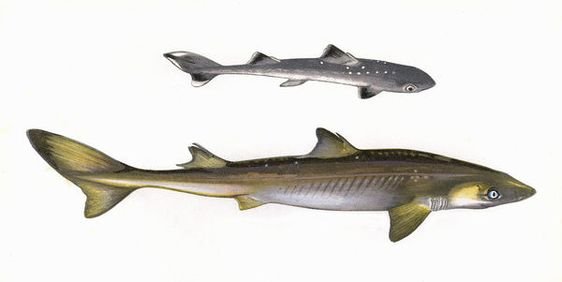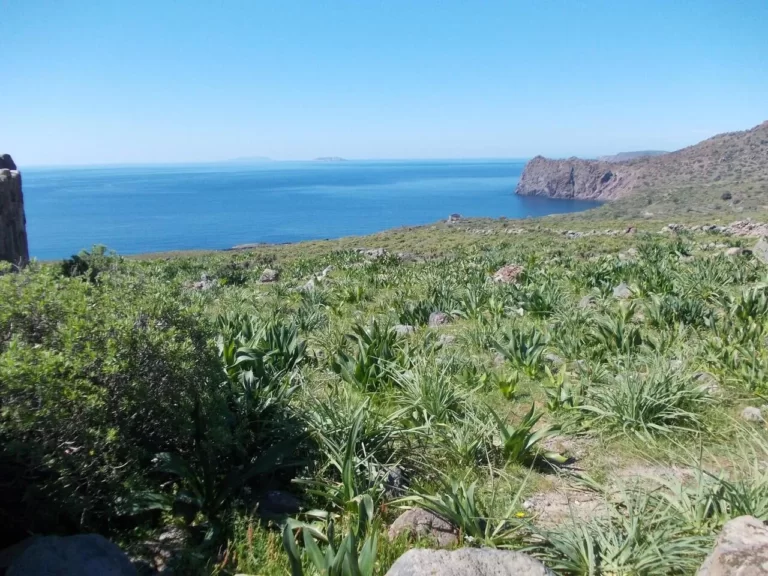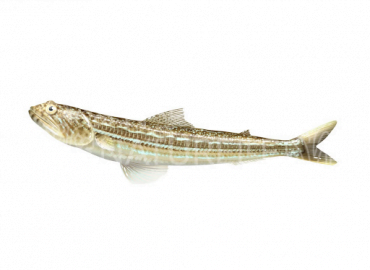Thunnus thynnus (Linnaeus, 1758)
Black and white drawing: (click for more)
See tree map display tree map
Synonyms
Thynnus thynnus Cuvier, 1817
Thynnus mediterraneus Risso, 1826
Thynnus vulgaris Cuvier in Cuvier & Valencienes, 1831
Thynnus orientalis Temminck & Schlegel, 1844
Thunnus vulgaris South, 1845
Thynnus secundo-dorsalis Storer, 1855
Orcynus thynnus Poey, 1875
Orcynus schlegelii Steindachner in Steindachner & Döderlein, 1884
Albacora thynnus Jordan, 1888
Thunnus thynnus Jordan & Evermann, 1896
Thunnus schlegelii Jordan & Snyder, 1900
Thunnus secundodorsalis Jordan & Evermann, 1926
Thunnus thynnus thynnus Serventy, 1956
FAO Names
En – Atlantic bluefin tuna, Fr – Thon rouge de l’Atlantique, Sp – Atún rojo del Atlántico.
3Alpha Code: BFT Taxonomic Code: 1750102601
Scientific Name with Original Description
Scomber thynnus Linnaeus, 1758, Systema Naturae, ed. X:297-298.
Diagnostic Features
A very large species, deepest near middle of first dorsal fin base. Gillrakers 34 to 43 on first arch. Second dorsal fin higher than first dorsal; pectoral fins very short, less than 80% of head length (16.8 to 21.% of fork length), never reaching the interspace between the dorsal fins. Ventral surface of liver striated. Swimbladder present. Vertebrae 18 precaudal plus 21 caudal. Colour: lower sides and belly silvery white with colourless transverse lines alternated with rows of colourless dots (the latter dominate in older fish), visible only in fresh specimens; first dorsal fin yellow or bluish; the second reddish-brown; anal fin and finlets dusky yellow edged with black; median caudal keel black in adults.
Geographical Distribution
Distribution Map
There are at least 2 subspecies, one in the Atlantic and one in the Pacific.The Atlantic subspecies is found from Labrador and Newfoundland south into the Gulf of Mexico and the Caribbean Sea and is also known off Venezuela and Brazil in the western Atlantic; in the eastern Atlantic it occurs from the Lofoten Islands off Norway south to the Canary Islands and the Mediterranean Sea. There is also a population off South Africa. The Pacific subspecies is known from the Gulf of Alaska to southern California and Baja California in the eastern Pacific; in the western Pacific, it occurs from Sakhalin Island in the southern Sea of Okhotsk south to the northern Philippines.

Habitat and Biology
Epipelagic, usually oceanic but seasonally coming close to shore.Northern bluefin tuna tolerate a wide range of temperatures. Up to a size of 40 to 80 kg, they school by size, sometimes together with albacore, yellowfin, bigeye, skipjack, frigate tuna, eastern Pacific bonito and/or yellowtail amberjack (Seriola lalandi).In the northeastern Pacific, T. thynnus tend to migrate northward along the coast of Baja California and California from June to September. Off the Pacific coast of Japan they migrate northward in summer and southward during winter. Large fish may enter the Sea of Japan from the south in early summer and move as far north as the Okhotsk Sea; most leave the Sea of Japan through Tsugara Strait, north of Honshu. Onset of maturity is at about 4 or 5 years,
and large adults (age 10 +) are known to spawn in the Gulf of Mexico and in the Mediterranean Sea. In the Pacific, spawning occurs northeast of the Philippines. In recent surveys, larvae have been discovered east of the Kuroshio, in the transitional fronts. Females weighing between 270 to 300 kg may produce as many as 10 million eggs per spawning season. Variations in the food spectrum are attributed primarily to behavioural differences in feeding. ‘Vigorous pursuit’ would be required to prey on small schooling fishes (anchovies, sauries, hakes) or on squids, while ‘modified filter-feeding’ is used to feed on red crabs and other less agile organisms.In turn, northern bluefin tuna are preyed upon by killer whales (Orcinus orca), pilot whales and blackfish. However, the rather large size of adults drastically reduces the number of potential predator species.
Size
Maximum fork length over 300 cm; common to 200 cm. The all-tackle angling record is a 679 kg fish of 304 cm fork length taken off Aulds Cove, Nova Scotia in 1979. The biggest fish in the various North Atlantic fisheries range between 540 and 560 kg in recent years. In the warmer waters off the Canary Islands, the biggest fish in commercial catches range between 350 and 400 kg.
Interest to Fisheries
Catch statistics were reported by 25 countries for 9 fishing areas, Fishing Area 61 alone accounting for almost half the total. The country taking the largest catches of northern bluefin tuna is Japan (28 628 t in 1981), and it operates in almost all fishing areas with its long-distance fleets. World catches of T. thynnus have remained more or less stable oscillating around 36 000 t between 1975 and 1980, while in 1981 they increased to 46 000 t (FAO, 1983). T. thynnus is caught with different types of gear, such as trap nets, purse seines, longlines, trolling lines and others. Some of the oldest fisheries documented are Mediterranean trap fisheries. Off Sicily, northern bluefin tuna are traditionally caught in the “tonnare” (Tuna trap fishing), or by harpooning from the “antenna” vessels. Traps similar to the “tonnare” are also used off southern Spain and Morocco. The species also formed the basis of ancient specialized fisheries off the eastern USA and Canada, and is presently avidly sought by big game fishermen on hooks and lines.
It is marketed fresh or deep frozen in Japan; the belly portion fetches particularly high prices when containing much fat.In late 1982, the International Commission for the Conservation of Atlantic Tunas (ICCAT) increased the 1983 catch limit for the western Atlantic to 2 660 t. This quota is subsequently divided among the contracting parties (Canada, Japan and USA). Concern about the continued low level of abundance of small northern bluefin tuna resulted in an ICCAT decision to limit the catch of fish smaller than 120 cm to 15% by weight of the total catch in the western Atlantic. In these waters, the fisheries are also controlled through number of licences, limitation of fishing season, minimum size and maximum-catch-per-boat-and-day-regulations. The sport fishing boats are also obliged to report a descriptive log of their operations on a weekly basis, and use prescribed gear. The total catch reported for this species to FAO for 1999 was 53 536 t. The countries with the largest catches were Japan (15 868 t) and France (6 741 t).
Local Names
ARGENTINA : Atún aleta azul , Atún rojo .
BRAZIL : Atum .
BULGARIA : Ton .
CHILE : Atún cimarrón , Atún de aleta azul .
CHINA : Cá chan , Thu .
COLOMBIA : Atún , Atún de aleta azul .
CUBA: : Atún aleta azul .
DENMARK : Thunfisk .
DOMINICAN REPUBLIC : Atún .
EGYPT : Tunna .
FINLAND : Tonnikala .
FRANCE : Thon rouge .
GERMANY : Roter Thun .
GREECE : Tónnos .
ICELAND : Túnfiskur .
ISRAEL : Tunna kehula .
ITALY : Tonno .
MALTA : Tonn .
MARTINIQUE : Thon rouge .
MEXICO : Atún de aleta azul .
MOROCCO : Thone .
MONACO : Tono .
NETHERLANDS : Tonijn .
NORWAY : Makrellshørje , Sjorje , Thunfisk .
PERU : Atún de aleta azul .
POLAND : Tunczyk zwykly , Tunczyk blekitnopletwy .
PORTUGAL : Atum .
ROMANIA : Ton , Ton rosu .
SOUTH AFRICA : Blouvin-tuna , Bluefin tuna .
SPAIN : Atún .
SWEDEN : Makrilstörje , Röd tonfisk , Tonfisk .
TUNISIA : Toun ahmar .
TURKEY : Orkinos .
UK : Bluefin tuna , Tunny .
URUGUAY : Aleta azul , Atún rojo .
USA : Bluefin tuna .
former USSR : Solsheglazyj tunets , Krasnyj tunets , Sineperyj tunets , Sinij tunets , Vostochnyj tunets , Zoludoj tunets .
VENEZUELA : Atún aleta azul .
YUGOSLAVIA : Tun .
ANGOLA : Atum , Rabilha .
Remarks
Two subspecies were recognized by Gibbs & Collette (1967): T. thynnus thynnus (Linnaeus) in the North Atlantic and T. thynnus orientalis Temminck & Schlegel in the North Pacific.
Source of Information
FAO Species Catalogue. Vol. 2. Scombrids of the world. An annotated and illustrated catalogue of Tunas, Mackerels, Bonitos and related species known to date.Collette, B.B. & C.E. Nauen 1983.. FAO Fish. Synop., (125)Vol.2:137 p.

























































































































































































































